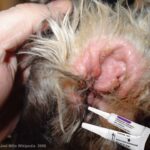More Information On Ear Infections In Dogs And Cats – Otitis Externa & How To Treat Them
Ron Hines DVM PhD
 Another article on the same subject
Another article on the same subject
 Ear surgery for a permanent cure
Ear surgery for a permanent cure
 Repeated ear infections and hypothyroidism
Repeated ear infections and hypothyroidism
 Cytopoint® for allergies, the root of many ear problems
Cytopoint® for allergies, the root of many ear problems
 Ear Infections & A Rare Dry Eye Problem?
Ear Infections & A Rare Dry Eye Problem?
 Some repeat infections are due to your pet’s ear anatomy, but in dogs, many more are due to atopic dermatitis (aka allergies). When that is the case, ear antibiotics can do more harm than good. Read about that here.
Some repeat infections are due to your pet’s ear anatomy, but in dogs, many more are due to atopic dermatitis (aka allergies). When that is the case, ear antibiotics can do more harm than good. Read about that here.
One of the most frequent problems veterinarians see in pets are inflammations and infections of the ear. It is the second most common reason that dogs are brought to veterinary hospitals, and the seventh most common reason cats are. The medical term for this is otitis. The first sign of this problem is your pet’s shaking its head or pawing at its ear. Soon it may begin to tip its head to the most bothersome side. With time, the condition often becomes quite painful.
Why Are Dogs So Susceptible To Ear Infections?
There are four common reasons why pets have frequent bouts of otitis – considerably more than cats do. The first three are due to how we have bred ear-shape over the years that dogs have become man’s best friend. Another common problem that often leads to ear issues is allergic skin disease. Ear canals are subject to that same itchiness and inflammation brought on by allergies.
1. Floppy Ears
The first was the advent of pets with floppy ears. Floppy ears trap moisture and air within the ear canal and make it an ideal place for bacteria and yeast to grow. This results in infection and inflammation as bacteria and yeast proliferate. Cocker Spaniels, Setters, Basset hounds, Beagles and, Shar Peis commonly have this problem, but any breed or mutt with floppy ears is more susceptible than a pet with ears that stand erect.
2. Allergies
The second most common cause of ear problems in dogs is their high prevalence of inherited skin allergies. When humans become allergic to things in our environment we suffer from nasal, and lung congestion as the body produces histamines. But in dogs, histamines cause itching and irritation. The ear is lined with very sensitive waxy skin, that also becomes itchy in allergic dogs. As a pet scratches and rubs at its ears, it causes inflammation and the release of moist exudates that grow bacteria and molds. The result is an ear infection or otitis. Labrador retrievers, Setters, Cocker Spaniels, West Highland Terriers, Schnauzers and Wheaten Terriers come to mind when one thinks of this problem, but any breed or mutt is susceptible. Flea infestation will also cause generalized itching and allergies in some pets. So, fleas can also lead to otitis. Allergic causes of otitis are much rarer in cats.
3. Excessive Hair In Ear Canals
The third most common cause of ear problems in specific breeds of dogs is the presence of thick hair within the ear canal. For reasons unknown to me, certain breeds have been developed that have luxuriant hair growth within their ear canals. This hair traps debris, moisture, and earwax within the ear canals, which again sets up the condition for bacterial and fungal (yeast) growth. Breeds associated with this problem include Poodles, Maltese, Pekingese, Spaniels, Schnauzers, Lhasa Apsos and Shih Tzus. It is not a common cause in cats.
4. Ear Mites
The fourth is the high incidence of ear mites in young puppies. Ear mites (Otodectes cynotis) irritate the lining of your pet’s ear canal. With time, this irritation leads to infection. By the time the pet is examined by your veterinarian, the ear mites may all be gone. But in many cases of otitis in younger pets, the initial problem was mites.
What About Ear Infections In Cats?
Ear mites are the leading cause of ear infections in cats. If mites are still present, they can be killed easily with numerous medications your veterinarian dispenses. If mites are not present in your cat, and it is still subject to repeated ear problems, it should be tested for feline immunodeficiency virus and feline leukemia. If you have multiple cats, they all need to be treated.
Are There Other Causes?
In the Southern USA, veterinarians see quite a few ear issues in large breed dogs that are associated with swimming in swimming pools and stagnant fresh water.
Otitis is also seen associated with abnormal ear wax formation. In some dogs, the normally oily wax is replaced with a cheesy coagulated material that builds up within the ear canal. Perhaps this is a genetic problem.
There is controversy as to the part hypothyroidism might play in leading to chronic otitis in some pets.
Overweight and obese pets are more susceptible to ear issues because the amount of air that can circulate within their ear canals is limited.
What Can I Do For My Pet?
Whatever the cause of your dog’s ear concerns, there are some general guidelines that apply in all cases.
The first is to not give up hope. It is bothersome to you and painful to your pet, but otitis can be cured or at least controlled. It just takes persistence. The first thing to do is to attempt to eliminate the cause. If fleas are present, use one of the modern methods of flea control. If other allergies are suspected, try a hypoallergenic diet available through your veterinarian or one you prepare yourself. Use it for a minimum of 90 days before deciding if it is helpful.
Remove The Hair From The Ear Canals
Hair growing within the ear canals can be plucked out with forceps like these. This is not as painful to the dog as you might think. Blunt the ends of the forceps and polish them with a flame, so they cannot injure your pet’s ears. A caring veterinarian or groomer should be able to supply you with a pair of hemostats (forceps) and instruct you in using them to remove the offending hair. A puff of talcum powder or starch will help you grip the hair.
Keep Your Pet’s Ear Canal Acidic
Conditions within the ear can be changed with medications to discourage the growth of bacteria and yeast. Most of these products make the ear canal more acid. Yeast and bacteria do not grow well in an acidic medium. I like formulas for ear washes that combine propylene glycol, boric and salicylic acid (citric acid might also be an option). (read here). The ear canal can be filled with this liquid and then vigorously massaged. When you finish, allow the dog to shake his head rigorously to sling out the wax and debris. Once a mild flare-up has subsided, treatment with only a few drops, done weekly, is usually sufficient to keep the problem under control. More serious head-shaking and pawing need your veterinarians attention and advice. Your vet has more powerful prescription ear products. Remember that dogs and cats that have had an incident of ear difficulties are at a higher risk of having them again. So, you may want to continue weekly applications of these over-the-counter otic solutions indefinitely.
The Problem With Long-term Use Of Antibiotic-Containing Products
Veterinarians will often send you home with ear drops or a tube of ear ointment. These ointments generally contain antibiotics to kill bacteria, antifungal compounds to kill yeast and corticosteroid to decrease inflammation and itching. All these medications bring fast relief. However, with continued use, new, antibiotic resistant bacteria emerge. Try not to obtain the same antibiotic formulation twice in a row. Alternate products to reduce the chances of resistant bacteria developing. Emerging resistance is why, whenever possible, I use non-antibiotic, bacteriostatic, ear washes rather than ear ointments and drops that contain antibiotics. Needlessly exposing potentially pathogenic bacteria that reside in your household to long-term antibiotics can be a threat to all family members. (read here)
Surgical Options
If and when medical treatment is not enough, there are two surgical procedures, which are very successful in curing ear problems or at least bringing long-term relief to your pet. If the middle and inner ears are still intact, the ear canal can be surgically shortened and bent downward to facilitate good drainage. This procedure is called a Zepp otoplasty. If the middle and/or inner ear is already involved, a more radical surgery called ear canal ablation or subtotal ablation is usually quite successful in bringing permanent relief to your pet. The quality of life after these procedures is generally very good. It is so rewarding to me to see these pets finally free of pain. Read more about that surgical option here.
Not all cases of anal sac impaction or recurring anal sac or anal fistulas can be successfully treated medically. Until recently, veterinarians relied on electrocautery units or careful scalpel dissection to perform surgery in areas where there was abundant blood supply, such as your dog or cat’s anal sac area. The older method, electrocautery, is quite successful in sealing bleeding blood vessels, but it caused damage to adjoining tissue, swelling and scaring that can narrow the rectal canal. C02 lasers have been used in human medicine for many years. They were primarily used by plastic surgeons to resurface skin, and perform delicate facial surgery. Until recently, the price of these lasers put them beyond the budgets of most veterinarians. C02 lasers vaporize tissue very precisely. At the same time, they seal blood vessels, preventing excessive hemorrhage and removing the need to tie off small bleeding blood vessels one by one. I attended a seminar at which a Houston, TX veterinarian reported that they now perform all anal sac removal using a CO2 laser. That should become more and more prevalent as machines reach the secondary market.
Is There A Newer Option?
Yes
Until recently, veterinarians relied on electrocautery units to perform surgery in areas where there was abundant blood supply, such as the ears. Electrocautery is quite successful in sealing bleeding blood vessels, but it causes some damage to adjoining tissue and some swelling as well. It is still the most common method veterinarians use today. C02 lasers have been used in human medicine for many years. They were primarily used by plastic surgeons to resurface skin, and perform delicate facial surgery. But the price of these laser units puts them beyond the budgets of most veterinarians until recently. C02 lasers vaporize tissue more precisely than electrocautery. At the same time, they seal blood vessels, preventing excessive hemorrhage and remove the need for your veterinarian to tie off the many small bleeding blood vessels one by one. I attended a seminar in Houston, TX recently where a specialty veterinarian reported that he had managed to avoid ear ablation surgery. Ablation surgery ends ear pain, but it also minimizes or eliminates your pet’s ability to hear. He and his colleagues do surgery to end your pet’s chronic otitis using a C02 laser to “sculpture” the inner ear. He mentioned that several laser surgeries might be required. Also mentioned was that the end result was not always successful, but if it were not, they could always perform an ear ablation at a later date. Likewise, he noted that several laser surgeries might be necessary. What was also mentioned was that many dogs in which this procedure was unsuccessful were found to have deep, middle ear infections that were not recognized at the time of surgery. The number mentioned was 20%.
You are on the Vetspace animal health website
Visiting the products that you see displayed on this website help pay the cost of keeping these articles on the Internet.





